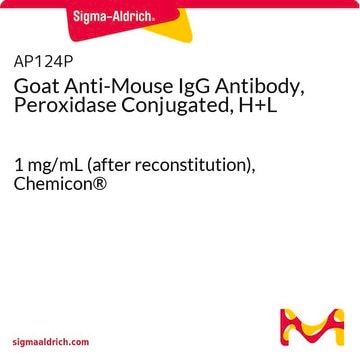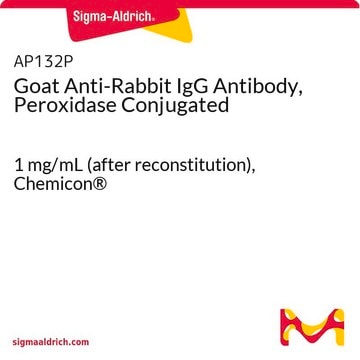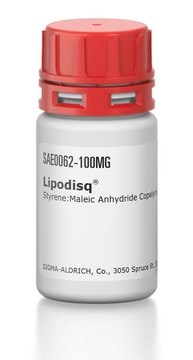L9045
Lipodisq®
Styrene:Maleic Anhydride Copolymer 3:1
Se connecterpour consulter vos tarifs contractuels et ceux de votre entreprise/organisme
About This Item
Code UNSPSC :
12352202
Nomenclature NACRES :
NA.26
Produits recommandés
Source biologique
synthetic
Forme
powder
Température de stockage
room temp
Vous recherchez des produits similaires ? Visite Guide de comparaison des produits
Description générale
Lipodisq® reagents are novel polymers derived from styrene and maleic acid. Lipodisq® polymers are capable of forming nanosized lipid-based discoidal particles capable of incorporating membrane proteins. Lipodisqs typically have a diameter of 9-10 nm at pH 7.4.
Application
Lipodisq® reagents are novel polymers derived from styrene and maleic acid. Lipodisq polymers are capable of forming nanosized lipid-based discoidal particles capable of incorporating membrane proteins. The Lipodisq technology can solubilize commonly used lipids such as dimyristoylphosphatidylcholine (DMPC) without the use of detergents. In general, Lipodisq polymers are potentially useful in mitigating the use of detergents for the solubilization of membrane proteins. Lipodisqs typically have a diameter of 9-10 nm at pH 7.4.
The Lipodisq technology can solubilize commonly used lipids such as dimyristoylphosphatidylcholine (DMPC) without the use of detergents.
Functional pH range: 6.0 - 9.0
Functional pH range: 6.0 - 9.0
Actions biochimiques/physiologiques
Lipodisq® polymers are potentially useful in mitigating the use of detergents for solubilization of membrane proteins. Dissolving this product in an aqueous solution, with sufficient base (e.g. KOH, NaOH), causes hydrolysis of each anhydride moiety into two carboxylic acid/carboxylate groups. This action renders the SMA polymer soluble in aqueous media. Lipodisq® acts as a potential membrane mimic system.
Informations légales
Lipodisq is a registered trademark of Malvern Cosmeceutics Limited
Produit(s) apparenté(s)
Réf. du produit
Description
Tarif
Code de la classe de stockage
11 - Combustible Solids
Classe de danger pour l'eau (WGK)
WGK 3
Point d'éclair (°F)
Not applicable
Point d'éclair (°C)
Not applicable
Certificats d'analyse (COA)
Recherchez un Certificats d'analyse (COA) en saisissant le numéro de lot du produit. Les numéros de lot figurent sur l'étiquette du produit après les mots "Lot" ou "Batch".
Déjà en possession de ce produit ?
Retrouvez la documentation relative aux produits que vous avez récemment achetés dans la Bibliothèque de documents.
Detergent-free incorporation of a seven-transmembrane receptor protein into nanosized bilayer Lipodisq particles for functional and biophysical studies
Orwick-Rydmark M, et al.
Nano Letters, 12(9), 4687-4692 (2012)
Indra D Sahu et al.
Biochemistry, 52(35), 5967-5984 (2013-08-22)
Electron paramagnetic resonance (EPR) spectroscopy is a very powerful biophysical tool that can provide valuable structural and dynamic information about a wide variety of biological systems. The intent of this review is to provide a general overview for biochemists and
Juan F Bada Juarez et al.
Chemistry and physics of lipids, 222, 51-58 (2019-05-19)
Lipodisq™ nanoparticles have been used to extract surface lipids from the cuticle of two strains (wild type, N2 and the bacteria-resistant strain, agmo-1) of the C. elegans nematode without loss of viability. The extracted lipids were characterized by thin layer
Characterizing the structure of lipodisq nanoparticles for membrane protein spectroscopic studies
Zhang R, et al.
Biochimica et Biophysica Acta - Biomembranes, 1848(1), 329-333 (2015)
Maria Lyngaas Torgersen et al.
Journal of biomedical nanotechnology, 16(4), 419-431 (2020-09-25)
Many promising pharmaceutically active compounds have low solubility in aqueous environments and their encapsulation into efficient drug delivery vehicles is crucial to increase their bioavailability. Lipodisq nanoparticles are approximately 10 nm in diameter and consist of a circular phospholipid bilayer
Notre équipe de scientifiques dispose d'une expérience dans tous les secteurs de la recherche, notamment en sciences de la vie, science des matériaux, synthèse chimique, chromatographie, analyse et dans de nombreux autres domaines..
Contacter notre Service technique








